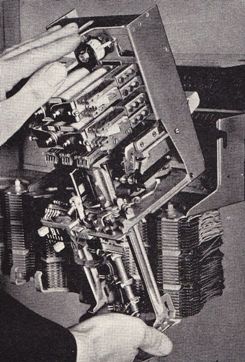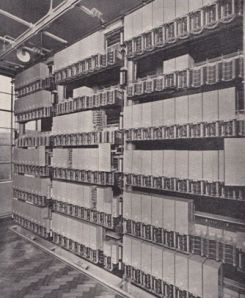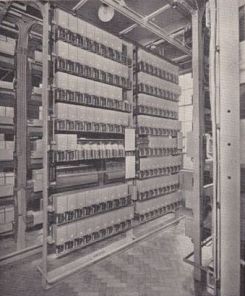
Intermediate Distribution Frame

The Grand Opening
 A picture in concentration - Two aspiring telecommunications engineers carrying out initial testing of newly connected subscribers lines at the opening of Upholland Telephone Exchange c1963.
A picture in concentration - Two aspiring telecommunications engineers carrying out initial testing of newly connected subscribers lines at the opening of Upholland Telephone Exchange c1963.
I think it's fair to say that the new technology was not universally welcomed with open arms, especially in the remoter rural locations like Elmers Green. Up to this time the community had enjoyed a very personal telephone service provided by the operators of the manual telephone exchange in the front room of a terraced cottage at the lower end of Parliament Street just below the slipper works of Lord and Sharman and Baxters Grocery and Electrical stores. Naturally many people didn't want to lose the facility to just pick up the phone and ask the operator for the number required, most of them were on first name terms with the operators and in many cases subscribers names were used rather than telephone numbers. However post war modernisation was well under way and the conversion was after a few anxious moments a tremendous success.The pictures below are typical of the Strowger 2000 type equipment fitted at Upholland, although some improvements had already been incorporated. For example: the equipment colour scheme was changed from grey to cream; parquet floors became PVC tiles; overhead lighting became fluorescent with diffusers slung below the ironwork; overhead cable runways were replaced by steel grid mesh and point to point cabling. The exchange covered an area from Orrell Post in the east to Tawd Vale in the west and from Winstanley College and Billinge in the south to Roby Mill and Appley Bridge in the north, it was part of the 0695 (Ormskirk) charge group.
A Wider View Intermediate Distribution Frame Subscribers Uniselector Racks Linefinder with Vertical Marking Bank Group Selector with Cover Removed Group Selector Racks Final Selector Racks
The need for a modern communications network with greatly increased capacity had been identified in the early fifties as a priority and key to reviving a stagnant post war economy and improving employment opportunities as the nation looked forward to a peaceful and prosperous future. Equally it was recognised that the continued use of existing technology, namely electromechanical switching, many manual local exchanges and an operator controlled trunk network would not be practical, economic or sustainable in the longer term to meet the anticipated demand. Not only was the system extremely labour intensive from an operator assistance point of view the automatic equipment also required continuous attention in the form of planned and reactive maintenance. Just like the motor car the equipment required a comprehensive and effective maintenance regime which included responding to fault reports, periodic inspection, cleaning, lubrication and replacement of parts to ensure its continuing reliability. Add to this the enormous demand for buildings and floor space and the very power hungry nature of the equipment with rapidly spiralling costs of both land and energy, it is easy to see why change was necessary.
However recent developments in the field of semi-conductors were already exciting the scientific world and their weird and wonderful properties seemed to have the potential to remove many of the barriers to the economic expansion of the network required. With their versatility to act as amplifiers, switches, valves and rectifiers, their speed of operation (microseconds rather than milliseconds or seconds), compactness and relatively low power consumption, these devices were the obvious way forward. As discrete components or in microchip form they were to herald the dawn of the digital revolution and provide the ultimate solution, the next 25 years would be exciting times and see a complete transformation of the system. Based on the principle that speech can be transmitted using sampling techniques made possible by the infinitely superior switching speeds of electronics without losing any of the intelligence, it would now be possible to build solid state telephone exchanges using pulse code modulation (PCM) and time division multiplexing, and sponsored by government and involving most of the specialist equipment suppliers the hunt for the holy grail was now on.
In the meantime network growth would have to be accommodated using current technology and the implementation of subscriber trunk dialling proceeded immediately with the development and expansion of group and trunk switching centres in larger towns and cities, at the same time at the local level a change of code for operator assistance from "0" to "100" was required to facilitate the use of the prefix "0" for routing calls to the trunk network. This also required the replacement of the old fashioned black "A" and "B" button coin box equipment found in all the red telephone boxes, on which most people relied at the time, with a swish grey improved version. Because subscriber trunk dialling required registers to store dialled National Number Group codes and translators to recognise and convert them to routing digits, varying amounts of post dialling delay was introduced before the caller received a tone from the distant end, and since delays greater than ten seconds were considered unacceptable, it was only possible to connect 90% of national calls in this way. The rest would need to be connected via the transit network in which calls passed through intermediate switching centres using just the national number group code, forwarding the local information only when the final destination had been identified. The trunk network used high grade sometimes four wire circuits with both AC and DC signalling over co-axial and ordinary copper cables, often passing through strategically located radio and satellite links and repeater stations for balancing and amplification.
As time passed companies became increasingly unwilling to invest in "old technology" and demand was outstripping supply, alternative technologies would be needed to fill the gaps caused by delays in developing the new digital systems. These came firstly in the form of crossbar systems which had been popular with overseas administrations such as Venezuela and other South American countries for a number of years. These were still electromechanical but had fewer moving parts and were less susceptible to wear than Strowger equipment. They were also common control, identifying the destination from digits dialled before marking and switching a free speech path, as opposed to the step by step system, routing a call through a series of switching stages under the direct control of the digits dialled. Half way house systems designated TXE2, TXE4 then TXE4A became available later, these represented a great technological step forward, they were processor controlled and incorporated many electronic components, however they still relied on electro mechanical switching of the speech path. Although the reed relays used, single pairs of contacts enclosed in glass tubes within a copper wire solenoid were a major improvement they were still very analogue, there was still one final breakthrough to be made.
The new digital systems finally arrived in the early 1980's with the installation of experimental prototypes in East Anglia and at Hale in Liverpool and after many teething problems and setbacks the new systems were put into production. They were rolled out quite quickly across the network during the late 1980s and 1990s with the help of specially designed interface equipment to facilitate analogue/digital interworking as modernisation progressed. The communications revolution had come to fruition paving the way for today's internet, broadband, mobile communications and the many other advances in digital media which followed. A most interesting and rewarding journey for those of us who were lucky enough to be part of it and a true box of delights for those who have embraced the digital age and all the gadgets on offer.






Palfreyman January 2013
 Farthingale Publications: .....
Farthingale Publications: .....  Is a hobby web site containing articles of local interest to Lancastrians, some favourite walking and cycling routes, selected words and poetry, and some writings of more general nature as well as the authors own picture gallery. Access is available via the homepage and menu at the head of the page or via one of the direct links below.
Is a hobby web site containing articles of local interest to Lancastrians, some favourite walking and cycling routes, selected words and poetry, and some writings of more general nature as well as the authors own picture gallery. Access is available via the homepage and menu at the head of the page or via one of the direct links below.
Local Interest: A Cricket Calypso; A Lancashire Lullaby; Dust Upon God's Fair Earth; God's Choir; Isaac Watts 1674 - 1748; It's a Funny Life; John Byrom 1692 - 1793; John Lancaster Wigan MP; Jubilee Park Memorial, Ashton in Makerfield; Little Ships at War 1918; Mind Your Language; Not Much of a Warrior; Peveril of the Peak; Private Thomas Whitham VC; Richmond Hill Dairies; Scot Lane School Wigan; The Brocklebank Line; The Farewell; The Holy City Liverpool; The Lindsays of Haigh; The Nurburgring 1960; Thomas Aspinwall Miners Agent; Thomas Aspinwall Obituary; Thomas Linacre School Wigan; Upholland Telephone Exchange; Wigan Advertisements 1960; Wigan Old Bank 1792; Wigan Soldier Missing in Action.
Walking & Cycling: Abbey Lakes to Coppull Moor; A Lancashire Linear Walk; Blackrod or Bust; Chorley Ice Cream Walk; Cycle the Monsal Trail; Cycle the Sankey Valley; Douglas Valley Dawdle; Freshfield to Crosby; Haigh to Borsdane Wood; Irwell Valley Trail (Bury to Rawtenstall); Irwell Valley Trail (Bury to Salford); Moss Eccles Tarn; Three Counties Cycle Ride; Wigan Circular by Bike.
Words & Poetry: A Lancashire Mon; A Legend of Montrose; A Wet Sheet and a Flowing Sea; Aw’ve Turned me bit O' Garden O'er; Boat Song; Calm is the Sea; David Copperfield; Dombey and Son; Dover Harbour; Dust upon God's Fair Earth; God Bless these Poor Wimmen that's Childer; High Flight; Hymn Before Action; Jeff Unsworth's dialect poetry; King Cotton; Martin Chuzzlewit; Martyrs of the Arena; Mind Your Language; Only a Cranky Owd Foo'; On Th' Hills; Redgauntlet; Rogue Herries; The Antiquary; The Armada; The Bride of Lammermoor; Th' Coartin' Neet; The Cottage; The Darkling Thrush; The Donkey; The Fair Rosamond; The Fair Rosamond Comic; The Family Man; The Glory of the Garden; The Heart of Midlothian; The Pickwick Papers; The Rolling English Road; The Wanderer; The Wreck of the Hesperus; Toddlin' Whoam; Tommy; When Winds Breathe Soft; Wisdom.
Wallgate Chronicles:  Adolphe Adam; A Tale of Two Cities; A Walk in the Hills; Barnaby Rudge; Bookcase; Cat Bells; Desert Island Discs; Eay Times Uv Changed; Fidelio; Frank Whittle and the Jet Engine; Fun with Trigonometry; Hard Times; Hugo Boss comes to Wigan; In the footsteps of the Manchester Rambler; Ivanhoe; Little Dorrit; Lohengrin; Nicholas Nickleby; Our Mutual Friend; Rob Roy; Romance on a Budget; Semele; Surprise at the Philharmonic; The Battle of Solferino; The Bohemian Girl; The Fair Maid of Perth; The Force of Destiny; The Getaway Car; The Marriage of Figaro; The Old Curiosity Shop; The Ravioli Room; The Spectroscope; The Switchroom Wigan; Travels in Time 1960; Travels in Time 2010.
Adolphe Adam; A Tale of Two Cities; A Walk in the Hills; Barnaby Rudge; Bookcase; Cat Bells; Desert Island Discs; Eay Times Uv Changed; Fidelio; Frank Whittle and the Jet Engine; Fun with Trigonometry; Hard Times; Hugo Boss comes to Wigan; In the footsteps of the Manchester Rambler; Ivanhoe; Little Dorrit; Lohengrin; Nicholas Nickleby; Our Mutual Friend; Rob Roy; Romance on a Budget; Semele; Surprise at the Philharmonic; The Battle of Solferino; The Bohemian Girl; The Fair Maid of Perth; The Force of Destiny; The Getaway Car; The Marriage of Figaro; The Old Curiosity Shop; The Ravioli Room; The Spectroscope; The Switchroom Wigan; Travels in Time 1960; Travels in Time 2010.
Selected articles from the above listed:
 Richmond Hill Dairies - Pemberton - These pages contain some personal memories from my youth and my association with Richmond Hill Dairies, a local business I grew up with and remember with some affection. A well known and important feature of the local community in its day and part of the heritage of Pemberton, this is my attempt to commit some small snapshot of its history to print, I hope these pages paint a worthy picture.
Richmond Hill Dairies - Pemberton - These pages contain some personal memories from my youth and my association with Richmond Hill Dairies, a local business I grew up with and remember with some affection. A well known and important feature of the local community in its day and part of the heritage of Pemberton, this is my attempt to commit some small snapshot of its history to print, I hope these pages paint a worthy picture.
Mind Your Language - A humorous poem by "the bard of Haydock" George Anderton, inspired by memories of a trip to Bad Canstatt, Stuttgart Germany with the Haydock Male Voice Choir in 1975. This publication will bring a smile to the faces of not only those members who were there at the time and know the people involved but the wider population of Haydock as well who speak the language.
Wigan and the American Civil War - Wigan Coal and Iron Company, The Right Honourable John Lancaster MP for Wigan, the Confederate Raider Alabama, USS Kearsarge, Cherbourg and the yacht Deerhound all feature in the last great sea battle of the American Civil War.
Wigan Old Bank 1792 - A tragic boating accident on Windermere and a surprising journey through the social history of Wigan during the reign of Queen Victoria, highlighting the relationships between four families who played an important part in the commercial development of the town.
The Brocklebank LineDaniel Brocklebank (1741-1801), shipbuilder and mariner, a brief biography, and some background detail of his family and the shipping line he founded.
Little Ships at ZeebruggeAn account of a heroic attempt to block the port of Zeebrugge during the first World War, to protect supply routes into the UK by denying enemy submarines based there access to the open sea.
A Cricket Calypso - A short biopic of cricketer Cyril Washbrook and a snapshot of his career including his role in the West Indies tour of 1950 recorded in the lyrics of the Cricket Calypso.
Not Much of a Warrior - Wigan RLFC in the fifties and sixties, through rose coloured glasses. A golden age of legendary players and memorable moments, along with some personal memories.
 Lyme Hall, Disley, Cheshire
Lyme Hall, Disley, Cheshire